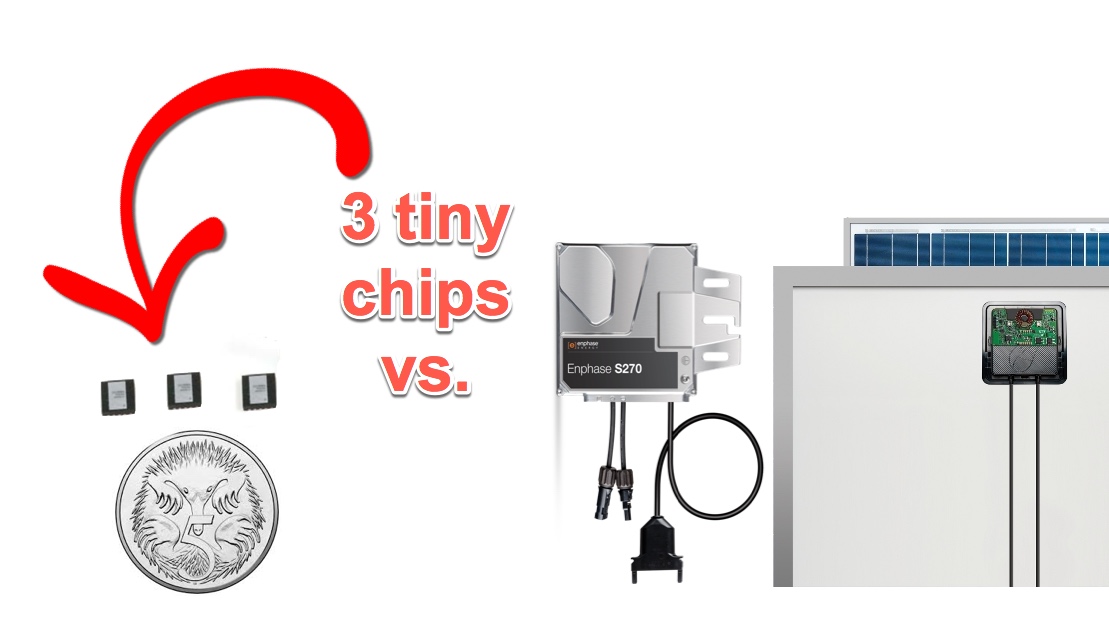
Are these 3 little chips all you need to optimise your panels for maximum energy output?
Maxim Integrated is a Californian electronics company that has been going strong for 33 years and has only ever been delisted from the Nasdaq Stock Exchange once. As you may be able to tell from their name, they like to integrate things and have developed a way to optimise the power from individual solar panels using 3 tiny chips embedded in the panel.
If you are wondering why panel optimisation is a good thing, this video explains it in about 20 seconds using the power of bird poo. The video proposes micro inverters as a solution, but DC optimisers achieve the same optimisation outcome.
Until now DC optimisers have been small boxes of electronics that are attached on or below individual panels. They work hard to maximize the electrical energy delivered.
On a roof without shading issues and where panels stay reasonably clean they may increase the amount of electricity produced by around 5%.
For a system which does have shade problems the performance improvement of optimised panels is typically over 15%.
Maxim Optimisers Are Cheap
Maxim Integrated says their technology is 7 Aussie cents a watt. That’s less than $20 for a typical panel. Currently panel level optimisation, which is less effective, costs roughly three times as much or more. Provided Maxim is being truthful, this is going to shake up the DC optimisation industry and hurt sales of microinverters.
Here’s how much extra you will typically pay for the 4 different panel optimisation technologies:
- Microinverters (e.g. Enphase)
- DC Optimisers (e.g. Tigo or SolarEdge)
- Smart Panels (i.e. panels with the optimiser box factory fitted such as Trina Smart Panels)
- Maxim Integrated
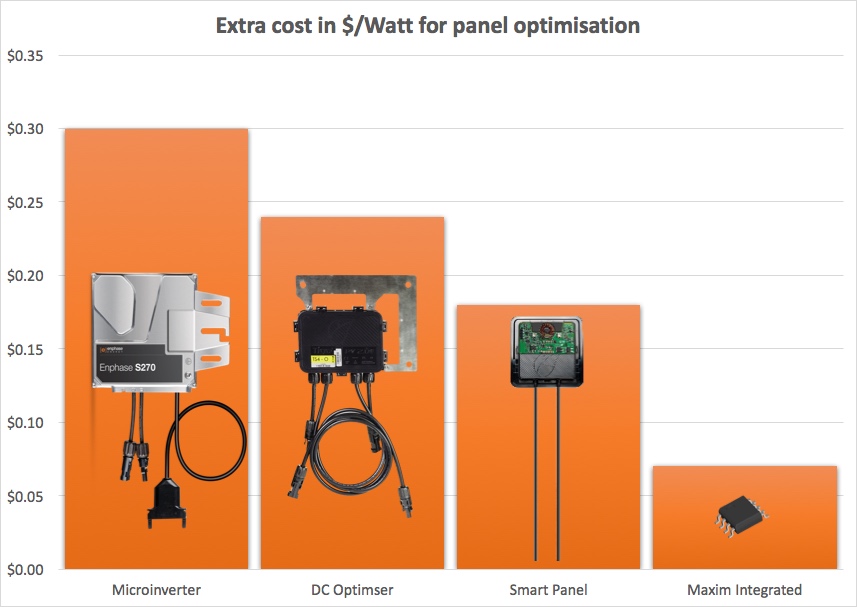
Maxim Integrated have slashed the costs of panel optimisation.
But not only are they cheap, Maxim’s optimisers are also more effective than a regular DC optimiser, because they don’t just optimise the panel, they optimise the cell-string. Read on to discover what this actually means.
Panel Level Optimisation
One way to be certain one shaded panel won’t affect the performance of others is to use microinverters. These tiny inverters turn each panel into an independent generator and send AC power directly to your home switchboard. They eliminate the need for a central string inverter and can be extremely reliable.
Another option is to use DC panel optimisers, which can either be built into the panel or in a box that gets bolted on later. While they work very differently from microinverters, they have a similar result. If one panel performs poorly its output will be adjusted so it will add to the total amount of power generated rather than harming the output of the others.
Both microinverters and DC panel optimisers only work at the level of the panel. If a bird poops on one panel it will stop it from affecting the others in the system, but they can’t do anything to improve the output of that panel. However, Maxim’s technology can – by optimising the performance of the solar cell-strings inside the panel.
Cell-String Optimisation
A solar panel may appear to be a large rectangle, but if you look at the way the way individual cells are wired together, it is actually one long snake made out of solar cells. A snake that is one cell wide and typically 60 cells long.
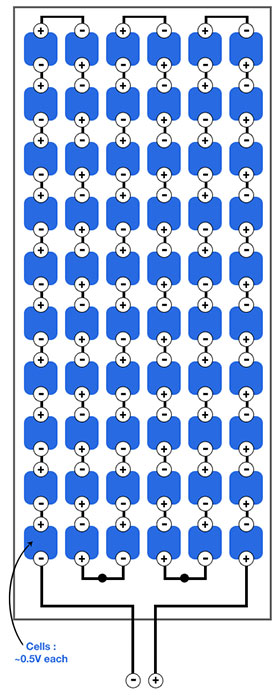
A string of 60 solar cells in series makes up a typical solar panel.
Because of this, if just one solar cell is covered by bird poop or a leaf it can affect the performance of every other cell in the panel. This happens because the current is reduced in the soiled cell, which reduces the current in all the cells.
To prevent a single poop spoiling the party for all the solar cells, bypass diodes are used to limit the harm caused by party poopers. This is what a diode looks like. It is about the size of a grain of basmati rice:
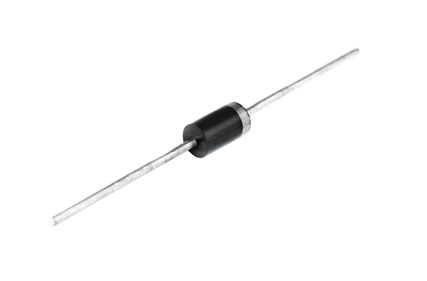
A bypass diode is used to bypass shaded cells.
A typical 60 cell panel is divided into three cell-strings of 20 cells each. If one of these cell-strings starts performing poorly its bypass diode will skip that string so it won’t reduce the output of the other two. Here’s how they are connected:
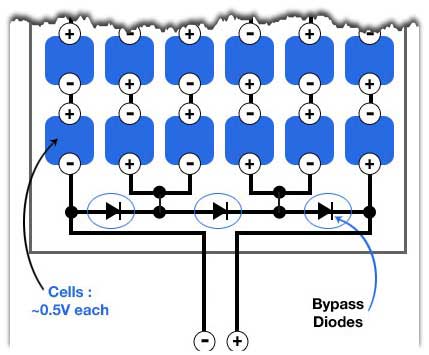
How bypass diodes are connected in a conventional panel
When a bypass diode is activated the cell-string that it bypasses contributes nothing, nada, zip. As a result, the panel’s output drops by a third. If 2 bypass diodes are activated, the panel loses 2-thirds of its power. In the unlikely event all 3 diodes are activated, you get nothing from the panel.
Maxim gets around this problem by optimising the output of each individual cell-string. If one of three cell-strings has its output reduced due to shade or poo or damage to a cell, then the tiny chip that replaces the bypass diode will optimise the cell-string so whatever power it generates is added to the total the panel produces instead of dragging the other two down to its level.
The easiest way to illustrate this is to use Maxim Integrated’s own illustration:
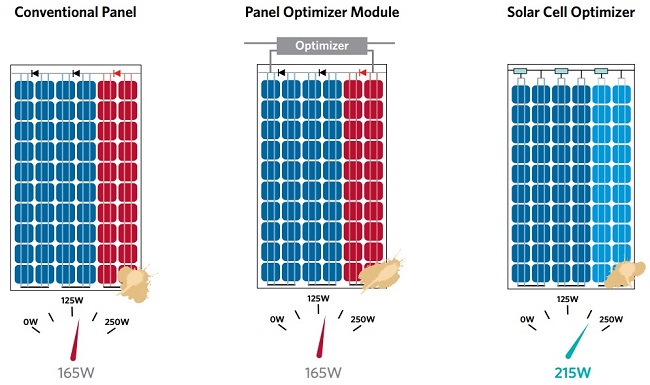
The effects of shading (bird poo) on a single solar panel. The one on the left is a standard solar panel. The one in the middle is optimised at the panel level. And the one on the right uses Maxim Integrated’s cell-string optimisation. (Image credit: Maxim Integrated)
As you can see with a standard panel on the left, a bird poop over a single solar cell can knock out an entire cell-string, which is one-third of a standard panel. It also has the same effect on the center panel which is optimised at the panel level. But Maxim’s cell-string optimisation is able to squeeze power out of the affected cell-string and contribute it to the total output.
SunPower Panels Bypass Individual Cells
On their illustration, Maxim Integrated describe their technology as a solar cell optimiser. And it is certainly true that it optimises solar cells. However, it would be more accurate to call it cell-string optimisation, as it works on that level and not on individual cells.
SunPower, an American company that produces panels with a 25 year product warranty, uses technology that is able to bypass individual shaded cells. According to Sunpower’s information they appear considerably better at handling shade than Maxim’s cell-string optimisation. But while they do an excellent job of reducing the effect of shade on individual panels, they won’t prevent one shaded panel dragging down the output of others on the same string in the panel array.
Maxim’s Chips Won’t Burn Out Like Diodes
Maxim Integrated is confident their technology will last for the lifetime of panels using it. While it is not possible to be certain it will function for 25+ years without either waiting that long or using a time machine, Maxim Integrated has run many tests and have used similar technology for decades, so they are very confident.
Optimisation that lasts a lifetime will be a significant improvement over bypass diodes which can and do burn out. While diodes in quality panels can last for decades, when they are placed in a situation that stresses them, such as actually bypassing cell-strings, they can eventually burn out rendering at least one-third of the panel useless. And once a diode has failed, total panel failure will often soon follow.
I would give a detailed description of the tiny chips Maxim uses to replace bypass diodes and optimise the output of cell-strings, but I won’t because then you might expect me to explain in detail how they work and that is something best left to an electronic engineer, of which I am not.
Maxim’s Optimisation May Extend The Life Of Panels
Unless Mick Jagger turns up and paints it black, a soiled or shaded cell-string will always produce some energy during the day. But if its bypass diode is activated that energy has nowhere to go and will end up as heat in the most heavily shaded cell. This creates a hot spot that can potentially damage the panel, degrade its performance, and even eventually cause the whole thing to fail.
But because Maxim’s optimisation will always work to contribute any current produced by a cell string to the panel’s total output, a cell-string is never bypassed which means hot spots are never created. This should, on average, increase the lifespan of panels and reduce their slow but gradual deterioration in efficiency as they age.
Maxim Panels Cannot Be Individually Monitored
The low cost of Maxim optimisation comes at a cost. There is always a price to be paid for low prices and in this case it is the lack of an inbuilt communication system. This means, unlike with standard panel level optimisation or microinverters, the performance of individual panels cannot be monitored. It is only possible to observe the total output of the system via the inverter.
Some people love being able to monitor the output of every panel on their array and if this sounds like you, then I am afraid Maxim DC optimisation will deprive you of the delights of solar panel voyeurism. But I find a large number of people, probably the majority, don’t give much of a damn about the details of their system’s performance and are happy just to just know their entire collection of panels are working at an acceptable level, which is something their inverter is able to tell them.
Multiple Panel Orientations Can Be Put On One String
For inverters that can only accept one string all the panels must face the same direction without optimisation. With perhaps one exception, which ever panels are receiving the least amount of light will pull down the performance of the others.
Most string inverters can now accept two independent strings of solar panels. But this still means households can only place their panels in two directions, limiting the amount of usable roof space and making installation on unusual roofs difficult.
But with optimisation the performance of one panel has no effect on the others and so it is possible to place panels facing in any direction desired. It would be possible for one string to have panels facing north, east, west, and south, and hung on the walls. Some could even be installed upside down, although that’s not recommended.
Racks Can Be Placed Closer Together
When racks of standard panels are installed on a flat roof or on the ground, enough space has to be left between them so they won’t shade each other in winter when shadows are the longest. Those who are desperate to get the maximum output out of a limited amount of space can place them closer so they shade each other a little, but if it is more than just a little they will lose more output than is gained.
But because Maxim optimised panels handle shade much better than standard panels, racks can be placed much closer together. According to Maxim Integrated, at around Sydney’s latitude it doesn’t matter how closely the racks are placed, the increased shading will never cause their total annual output to actually drop. Sure, it is probably pretty dumb to cram them in as closely as possible because it means paying for extra panels for diminishing returns, but for people with a limited amount of space it can be cost effective to place racks closer than normal.
Jinko and Trina To Use Maxim Integrated Optimisation
Jinko Solar has released its Eagle MX panels that use Maxim Integrated optimisation. Trina Solar has displayed a fully tested and certified panel using the technology in Los Angeles but it may not be ready for sale, as I can’t find any information about it online. Maxim Integrated says four or five other manufacturers will also soon release panels using their technology.
We will have to wait and see if the price premium on these panels will be as low as Maxim suggests. The first ones on the market may not lower their prices until competition forces them to, but hopefully it will soon get down to the promised 7 cents a watt.
Maxim Optimisation Makes Economic Sense
For a rooftop with no shading issues it may not be worth paying an extra 7 cents a watts for panels with Maxim optimisation. Sure, it would help limit the effects of the occasional bird poo, but using the money saved to pay for an extra panel or two should make up for those loses.
But 7 cents a watt is pretty cheap insurance to make sure one poorly performing panel won’t bring down the output of an entire string. It would also help future-proof your system in case a neighbor’s erection casts shade on your roof or a horde of fruit bats decide to move into the trees next door. It may also extend the life of your panels.
For anyone who does have shading issues, has a lot of birds or bats with high fibre diets in their area, or wants to install panels facing in more than one direction on a single string, then Maxim Integrated DC optimisation at 7 cents a watt appears to be a no brainer. If individual panel monitoring does not interest you, then you appear certain to get your money’s worth.
So Will Maxim Integrated Kill The Microinverter and DC Optimiser?
Will Maxim Integrated’s little chips actually do what I suggested in the headline and murder microinverters and traditional DC optimizers?
If Maxim’s claims hold up in the real world (and prove reliable enough in our harsh Australian conditions) then maybe.
If you are not interested in the other features offered by some DC optimiser boxes, such as panel level monitoring or rapid shutdown, then a Maxim powered panel promises more granular optimisation at a lower price than the established, discrete DC optimisers.
As for microinverters, they offer a few more benefits over DC optimisers that more people may be happy to pay extra for such as:
- the safety of 240V AC over high voltage DC
- reliability from no single point of failure
- no need for a central inverter
So despite their situation being sub-optimal, Microinverter manufacturers should feel a little less threatened, especially if they ever get to the holy grail of being cheaper than string inverters.
We’ll have to wait to see how the Maxim powered panels perform in the field. If they do what they promise then, for no-frills optimisation, those little chips from Maxim Integrated will be hard to beat.

 RSS - Posts
RSS - Posts



Thank you for the informative article, Ronald.
For many years, Maxim has been a respected innovator in the semiconductor industry, not least in power management devices. A compact DC-DC converter for PV applications is right up their alley. But the efficiency of the converters has not been mentioned yet. Let’s say it’s 96%, perhaps. Then we’d be paying the additional price of 4% loss on the whole array, when clean. If the thing is clever enough to be able to shut down the converter function when not needed, it could switch the cell-string on-line instead, with an on-chip power MOSFET, with _really_ negligible losses, but how would it know? (Reverse polarisation?)
If bypass diodes are burning out, then they’re under-dimensioned, full stop.
In addition to small axial-leaded devices, as pictured, there are cheap TO220 packaged dual diodes which handle 16A with aplomb, though they’ll need a heatsink. That’s some cell-string, I suggest. However, if it’s the high summer temperatures doing them in, then
a) A much more complex DC-DC converter is going to curl up its toes too, unless it includes a temperature sensor, and shuts down to protect itself, thereby cutting your power supply.
b) There are Silicon Carbide Shottky Diodes which are unaffected by temperatures which will destroy the plain Silicon PV cells and fry any Silicon semiconductor device. (Good for a junction temperature of 500K, i.e. 230 C.)
I think I’ll invest in a mop with a long handle.
Without the reporting of data at the module level you have to ask the question: how does one know when a module is malfunctioning? In other words a homeowner would need to monitor the PV array output overtime. A string installation would still have the problem of an open circuit, ground isolation faults, and high DCV in the installation.
Maxim came out with their chip in 2014. Be sure to go to the Jinko link below, they were the first to incorporate the chip in 2015.
http://www.jinko-smart.com
Thanks for providing a link, Richard. I presume you are specifically referring to this page:
http://www.jinko-smart.com/maxim.html
Hi Ronald,
No, I intended the link provided to reflect that Jinko also incorporates other optimizer solutions.
Ground-mount solar power plants is where the likely adoption would occur for panels incorporating the Maxim chip in the USA. Upcoming code requirements will require module level shut down for rooftops; this would require a communication link at the module. Trina (using Maxim) is offering a solution for this but it requires their cloud based service for full functionality in addition to the inverters’ cloud based service . None of this is going to be a killer to the Enphase microinverter. An elegant solution that solves all the problems of string inverters in the residential and commercial space of which requires clunky workarounds. Unfortunately many Myths continue to circulate about Enphase as the Goliath string inverter industry protects their turf.
Get an AuziMAX to monitor production. You will be able see any downward trend in production very early
Jinko has stopped with the DC Optimizers. Too many problems with it. They now only have the Maxim integrated panels.
At the moment it seems a 9 to 10 KW system can be about $2000 cheaper using panels with maxims integrated, as compared to an equivalent Solaredge system. Of course, you lose the benefits of panel level monitoring.
Do you think panel level monitoring is worth the additional cost? And is there likely to be any alternative technological method of providing this monitoring if one goes down the maxim road?
Hi Finn
Productivity wise, Do you think Jinko Maxim is a better option than Enphase Inverters
Hello Kam, Ronald here. I would say there is not enough information at the moment to say if one is better than the other. I would expect a DC optimized array and one with Enphase microinverters to operate at around the same level, assuming the panels are otherwise identical. But under some shading conditions I would expect Maxim Integrated panels to perform better. Enphase microinverters allow monitoring at the panel level while Maxim optimized panels don’t, and that is an important consideration for some people.
Thank you for your reply.
I don’t mind if I don’t have the panel level monitoring as long as the maxim is equal or better in production and shade conditions than Enphase
If there is something like a TV aerial casting a thin shadow, then a panel that is optimized at the panel string level should do better than one that is optimized at the panel level or has a microinverter. But for panels that are in solid shade, all types will perform terribly.
Thanks
Hi,
im just wondering that now we’re a few months down the track whether there has been any feedback on the efficiencies and/or reliability of the Jinko Maxims?
Hello Liam. I haven’t heard of any problems. Of course, I wouldn’t expect there to be. I expect the tech to be reliable and when we see manufacturers using it in panels with 15 year or longer product warranties that will be excellent evidence they regard it as reliable.
Update 31 May: I have just found out that Maxim optimized panels apparently can interfere with TV reception. Mark Cavanagh of MC electrical says it has occurred in 7 out of 27 installations where TV reception was apparently weak. They were able to correct the problem by installing new aerials:
http://mcelectrical.com.au/blog/test-maxim-optimised-panels-vs-solaredge/
Hi we have installed several houses now with full 24 x 265w Jinko Maxims and also mixed 270 Jinko with 265 Maxims. The one problem we have encountered in 2 houses so far is the panels block television station reception. Maxim and panel manufacturers need to provide a solution to this issue. There are frequency problems at the roof level inference blocks reception.
Thanks Ronald
What do you recommend if you have partial shading but no wifi, as we do, being in the country. And we have limited roof space.
Sue
Hi Sue,
All the options for coping with partial shading will work without Wi-Fi. The only thing you’ll lose is the monitoring – as that is done through the internet.
Finn
Ok. Thanks Finn and I love your website.
I am thinking of Trina with maxim or Suntech with either engie or DC optimiser. We might well add batteries later.
Do you have an opinion about which would be better?
Sue
Hello Sue, Ronald here.
Panels that use Maxim Integrated panel string optimization should give similar performance to using DC optimisers under most circumstances, although optimising at the string level should, technically give a slight advantage. I have been impressed with the low premium charged for panels that use Maxim’s technology, so they may turn out to be a cheaper option. Note that if only a few panels of your planned array(s) have shade issues, it is possible to place optimisers on just those panels. It would also be possible to just use panels with Maxim style optimization in those locations.
Suntech panels have the advantage of generally having a 12 year warranty rather than a 10 year one.
Hi Ronald
There’s one thing about all this that I really can’t get my head around. With these Maxim enhanced modules, even if it does optimise the production at a cell string level, the shaded module will still produce, overall, less than a totally unshaded one. For the sake of argument, let’s say the unshaded module is putting out 250V, the shaded one, optimised, 215V. Surely, that means, as it is a string installation, ALL the modules on the string are going to drop down to 215V?
And if I’m correct about that, then we are back to square one almost and favouring module level optimisers and micros again.
Hi Andrew. The neat thing about panel string optimization is each panel string will alter its current so it will only add its output to the DC circuit and not drag other panels it is connected to down to its level. So the end result is similar to having a traditional DC optimizer attached to a panel. Actually, it should be just like having 3 DC optimizers attached to a panel — one on each panel string.
we instal every week about 50 installations with jinko maxim integrated paneles and we see that the output from the installation is in every situation about 15 till 20 % more ten with traditionel installation, But when you put optimizer under the panels the output can never be more ten a tradionel installation without shade, so the maxim technoligie give much more output ten each other systeem i now from WP to kWh
Hi Ronald
I llive in Adellaide amd I want to install solar panels with micro invertets with Tindo. Can u advise please
Hello Lali.
Tindo uses Enphase microinverters with their panels. They have a page on microinverters here:
http://www.tindosolar.com.au/learn-more/micro-inverters/
Enphase microinverters, while not quite perfect, are considered very reliable.
If you want to use different microinverters it is possible to arrange that with an installer.
HI,
Great article. New technology never ceases to amaze me. The new tech comes along way faster than the time you need to pay off the loan for the initial PV system. 🙂
I think I have an interesting scenario for all to comment on.
I have installed a Solar Edge optimized PV system. As far as I know it is working fine. I systemically check the outputs; plus Solar Edge sends me a monthly report on the system’s performance.
I was always planning to increase the size of the roof top array. I incrementally increased the size until i reached 4000w in 2014. I have a 5000W inverter.
I do have some shading and bird dropping issues. The shading is due to the neighbour’s trees that have gotten taller. The birds think its cool to poo on my panels.
My question is, will the maxim integrated (cell optimized) modules work with the SolarEdge optimizer? I know i will be paying more in this (doubled optimised) scenario, but
a) I still want the information generated by the SolarEdge platform; as it helps identify potential issues with modules now and in the future.
b) My SolarEdge inverter will only work with SolarEdge optimizers.
c) I would like to add four more panels and the racking is already there for their placement. I am thinking of the Jinko MX panels.
d) I think ( i maybe be wrong) the additional optimizer on those four(4) MX panels should work, and those panels should perform even better than the single optimized panel when shaded. As the partially shaded MX panel cell string(s) will contribute some power as opposed to zero power.
e) I am far from reaching pay back on the original system. Starting over from the scratch does not look to pretty.
Any comments are most welcomed.
Hi boffins, can any of you please advise if having a three phase mains power supply is a consideration when choosing a solar system and will it effect cost/efficiency/safety?
Cheers
Solar can be easily installed on 3 phase. You just need to choose if you get a single phase inverter or a 3 phase inverter.
These FAQs will help you decide:
https://support.solarquotes.com.au/hc/en-us/articles/115001597114
https://support.solarquotes.com.au/hc/en-us/articles/115001462573-I-have-3-phase-power-Should-I-use-a-3-phase-inverter-or-a-single-phase-inverter-
Hi – I’ve noticed that with all this recent discussion involved with the maxim integrated panels, the hype that was behind the popularity of micro inverters has diminished – is this correct. Also, Enphase was considered the best option for micro inverters for sometime, has this now changed? I’m looking to improve the efficiency of my current 5kw split array system with micro inverters but can the maxim optimisers be retro fitted to my current Hanwha 260w panels. What would be the best option going forward?
Also, my current situation is that being in Tasmania, we have multiple tarriffs but my system can only be utilised against one of them. Do any of these options (micro inverters/ maxim integrated optimisers) allow me to utilise theses different tariffs more efficiently?
I’m afraid I can’t think of any way they’d let you make better use of tariffs.
Hello George.
I’m not certain whether people’s desire for microinverters has waxed or waned, but I can tell you that Ehphase microinverters, while not perfect, do have a good reputation for reliability.
Maxim panel string optimization cannot be added to existing panels. The cheapest way to add optimisation to an existing panel is to bolt on a Tigo optimiser box. They cost about $60 each plus installation. However, as the gains are likely to be small you may be able to find a better option for reducing electricity bills. (See my reply to your other recent comment.)
I am planning to have a system with 22 300 watt Q.Cells (6.6kW of panels). I have an east and west facing roof on my shed. I get partial shading on the west side after 3:30pm.
My thoughts are that I will put 14 panels on the east and 8 on the west. With shading this late in the day on one side only (and with a string having 33% of the panels) does the additional cost of micro inverters or optimizers make sense?
A complicating factor is that I am a ham radio operator and know that Solaredge and Maxim optimisers have been known to cause RFI. I believe the newest Enphase micro inverters are OK and I have no idea about Tigo optimisers. Perhaps Tigo is the way to go since I do not need to place them on 2/3 of the panels or perhaps I should forgo the optimisers and take a hit on late afternoon shading.
All advice is appreciated.
As the shade would cost you under 5% of your total solar electricity production, it would not be a huge loss. It would just be annoying when it comes to powering an air conditioner late in the afternoon, although both the east and west facing panels would still be producing some electricity even when the sun is very low in the sky in the afternoon.
I’m afraid I don’t know which microinverters are most likely to interfere with ham radio use. But I can say that Jinko’s first generation of panels with Maxim panel string optimization are no longer available due to interference with television reception, while their generation two panels that should be available early next year apparently solve this problem.
Hi Jim. I built 6 solar strings, starting in 2013. I now have about 20,000-Watts AC with 80 panels. I use the South, East and West roofs of my home and barn. I use microinverters to have panel independence, panel monitoring, and like the article says, reliability from any component failure. The rules for rapid shutdown are something to consider, and Enphase has always been rapid shutdown compliant. If you can wait for the IQ7-based ACM, then that would be ideal. I saw Tindo Solar selling some S-230-based ACM’s which are a great product. Whatever you decide, make sure that the STC rating for the panel is at least 1.15 to 1.25-times the inverter nameplate rating. I know a lot of people don’t care about the per-panel monitoring, but with Enphase, you can have an eMail setup to even bypass that monitoring responsibility. With older systems, it’s really hard to know if it is working 100% unless your utility bill doubles signifying there is a problem. A couple years ago, one of my panels did have a problem, so an easy fix was to just swap microinverters on the roof to see if the problem “travelled” — it did not, and I was quick able to deduce a panel issue, and I got it replaced under warranty. With a centralized topology, deducing the problem is not as easy. Good luck in your project. And one more thing, with microinverters, you can build your system one string at a time. The longer you wait, the better the technology gets! Cheers!
This was a year ago. Is there any follow on to this, especially for comms and monitoring of maxim optimised panels ?
The Gen 1 Jinko Maxim panels had issues with TV interference. They are just about to launch Gen 2 which Jinko claim fixes the problem. I don’t know of any individual monitoring for Maxim panels.
Greetings from the USA. Maxim is just getting traction in the US now. My 2 cents on the lack of panel monitoring is that the panel rarely fails. The MLPE (module level electronics, micro’s and dc optimisers) people tout panel level monitoring which is really just monitoring their own product. What typically fails is the MLPE.
String level monitoring, offered by most string inverters, is typically all a customer needs to watch the health of their system.
Hello Wesley
Do you know if 2nd generation Maxim optimized panels are currently being used in the United States? We got the first generation, but for some households they resulted in interference with television reception.
Anyone with Trina Maxim (TSM-PD050.8D (MAXIM)) panels? I am concerned with TV interference, and performance of the panel. Can TV interference issue be solved easily with digital antenna?
I am interested in maxim panels because of shading issue from chimney in early morning and late afternoon.
Thanks.
Hello from the USA. I’m looking for any distributor that would sell me the Maxim optimized panel from Jinka/Q.cell or Trina but I can’t find any. Does anybody have any idea on how I can find a distributor that will have these panels?
Thanks
Jinko Maxim panels aren’t available in Australia:
https://www.solarquotes.com.au/blog/jinko-mx-solar-panels/
Don’t know what’s happening with Trina ones but I can’t see any on their Australian site.
CED Greentech on the east coast had a bunch (750 KW) last fall.
Hello all – why is nobody talking about using panels with Maxim integrated power chips (ie: Trina, Suntech) *with* Micro-Inverters (ie: Enphase IQ 7) ?
Would this not offer easy panel level monitoring and high level optimisation via the Maxim chips?
Please forgive me if this suggestion is silly…
Hi Ronald
I’m considering installing 44 Suntech MAXIM integrated 300W MONO PERC panels on my roof with a 3-phase Fronius inverter.
Have you any experience/knowledge of how reliable Suntech MAXIM panels are/have been?
Thanks
Jesse
Early Maxim panels sometimes caused interference with TV reception. This issue has hopefully been fixed and even with the early ones it was generally only a problem where reception was weak. But it is something to keep in mind and check after the system is switched on. Suntech are generally reliable panels. They are tier one and have a 12 year product warranty which is better than some. Maxim optimized panels haven’t been around long enough to know how reliable they will be but the Maxim representative I spoke did a good job of convincing me they can be relied on.
If your solar panels well be shaded at times then Maxim optimised panels should be a very cost effective way of limiting losses. If you get them, let me know if they have any issues or if they have no issues.
Thanks very much, Ronald.
I was concerned about the TV reception problem but I am hoping the new model panels no longer has this problem as you’ve said.
I will let you know how it goes.
Thanks again.
Jesse